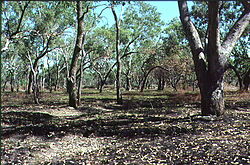- Eucalyptus coolabah
-
 Eucalyptus coolabah
Eucalyptus coolabah
Eucalyptus coolabah Classification classique Règne Plantae Sous-règne Tracheobionta Division Magnoliophyta Classe Magnoliopsida Sous-classe Rosidae Ordre Myrtales Famille Myrtaceae Genre Eucalyptus Nom binominal Eucalyptus coolabah
(Blakely) L.A.S.Johnson & K.D.Hill (1990)Classification phylogénétique Clade Angiospermes Clade Dicotylédones vraies Clade Rosidées Ordre Myrtales Famille Myrtaceae  Retrouvez ce taxon sur Wikispecies
Retrouvez ce taxon sur Wikispecies
D'autres documents multimédia
sont disponibles sur CommonsEucalyptus coolabah est un eucalyptus des zones ripariennes que l'on trouve dans toute l'Australie depuis les régions arides de l'intérieur aux régions côtières. La plante est communément appelée Coolibah ou Coolabah en anglais, un terme emprunté au mot gulabaa des Aborigènes Yuwaaliyaay.
Pour germer, la graine a besoin d'une immersion et, par conséquent l'espèce est confinée aux régions où il y a au moins des inondations périodiques. Néanmoins, l'arbre peut être trouvé sur de vastes étendues de plaines inondables même loin des zones d'eau permanente, ainsi que près des zones inondées périodiquement ou à proximité de plans d'eau permanents.
C'est un arbre de grande largeur (souvent plus large que haut) qui atteint jusqu'à 15 m de hauteur. L'écorce est en persistante, gris foncé, épaisse, sillonnée sur le tronc et les branches inférieures, mais gris pâle et lisse sur la partie supérieure.
Sommaire
Espèces semblables
Il est très semblable à E. microtheca. La principale différence extérieure est que ce dernier a une écorce complètement lisse.
Voir aussi
La célèbre chanson Waltzing Matilda de Banjo Paterson mentionne l'arbre :
Once a jolly swagman camped by a billabong,
Under the shade of a coolibah tree,
And he sang as he watched and waited till his billy boiled
"You'll come a Waltzing Matilda, with me."
Liste des espèces et sous-espèces
Selon Kew Garden World Checklist (28 déc. 2010)[1] :
- Eucalyptus coolabah Blakely & Jacobs (1934)
- sous-espèce Eucalyptus coolabah subsp. arida (Blakely) L.A.S.Johnson & K.D.Hill (1990)
- sous-espèce Eucalyptus coolabah subsp. coolabah
- sous-espèce Eucalyptus coolabah subsp. excerata L.A.S.Johnson & K.D.Hill (1990)
Notes et références
Liens externes
- Référence Kew Garden World Checklist : Eucalyptus coolabah (en)
- Référence Catalogue of Life : Eucalyptus coolabah Blakely & Jacobs (en)
Catégories :- Arbre
- Eucalyptus
- Flore (nom scientifique)
- Arbre d'Australie
- Eucalyptus coolabah Blakely & Jacobs (1934)
Wikimedia Foundation. 2010.
